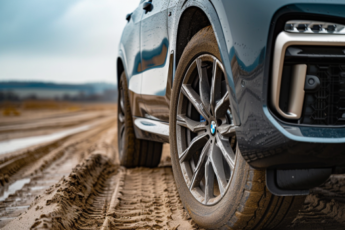Last Updated on 4 weeks
Comparing All-Season and All-Weather Tires for Year-Round Performance
Deciding on the right set of tires for your vehicle can be challenging, with many factors to consider in the quest for enhanced driving confidence. Amidst countless options, the age-old debate of all-season vs. all-weather tires continues to perplex drivers, leaving many wondering which tire will deliver year-round tire performance, regardless of rain or shine driving conditions. In this ultimate tire showdown, we dive into the characteristics and capabilities that set these tire categories apart, guiding you toward a better understanding so you can make an informed decision per your specific requirements.
Key Takeaways
- All-season tires deliver balanced performance in mild climates, suitable for handling dry and wet roads.
- All-weather tires flourish in unpredictable weather and harsher winter conditions, backed by their Three-Peak Mountain Snowflake (3PMSF) certification.
- Tread patterns and rubber compounds are critical in determining tire versatility and performance.
- Climate, driving habits, and budget are important considerations in your tire selection process.
- By evaluating long-term savings and upfront expenses, you can find the perfect balance between cost and value for your tire investment.
- Whichever tire type you opt for, optimal driving safety and confidence hinge upon pairing your choice with your specific needs and climate conditions.
- All-season and all-weather tires have distinct advantages catering to different driving situations, ultimately centered around providing year-round driving confidence.
The Essential Dilemma: All-Season and All-Weather Tires Explored
With a wide range of tire options, choosing the perfect set of tires for your vehicle can be daunting. The age-old debate between all-season tires versus all-weather tires continues to baffle drivers, as each offers a unique performance profile. While both types of tires provide remarkable benefits and versatility in different climates, understanding their respective characteristics will help you make an informed decision based on your driving habits, climate considerations, and budget.
All-season tires are known as the jack-of-all-trades option that meets the needs of most drivers in mild climates, offering satisfactory performance across various weather conditions while ensuring driving safety. On the other hand, all-weather tires deliver mastery in adverse road conditions, like heavy rain, snow, and ice, maximizing vehicle performance and driving confidence. To better understand the advantages and disadvantages of each tire type, let’s discuss their distinctive features:
- Tire Technology: All-season tires employ a balanced tread pattern to handle dry and wet surfaces adeptly, with moderate siping for light winter traction. All-weather tires are designed to tackle a broader range of weather conditions, utilizing advanced rubber compounds and siping techniques to enhance grip and stability on slippery surfaces.
- Driving Safety: All-season tires are best suited for mild climates where the fluctuations in weather conditions are relatively minor. In contrast, all-weather tires offer drivers greater peace of mind by providing enhanced traction and control during harsh winters or in locales with more dramatic seasonal changes.
- Vehicle Performance: While all-season tires focus on a comfortable and quiet ride ideal for daily commutes, all-weather options prioritize safety and versatility in difficult road conditions, ensuring a confident driving experience regardless of the weather.
Choosing between all-season and all-weather tires depends on your unique driving habits and requirements. To help you make the best decision for your needs, consider the following factors:
“What are my typical driving conditions? Is my climate predominantly mild, or do I often encounter icy roads and heavy snowfall? How important is driving safety to me compared to a quiet and comfortable ride?”
| Features | All-Season Tires | All-Weather Tires |
|---|---|---|
| Weather Suitability | Mild climates, light snow | Wide range of weather conditions, including heavy rain and snow |
| Driving Safety | Acceptable performance, suitable for daily commuting | Superior traction and control, ideal for unpredictable road conditions |
| Vehicle Performance | Comfortable, quiet ride | Confident driving experience, regardless of weather |
| Budget Considerations | Generally more affordable upfront | It may require a higher initial investment but provide potential long-term savings. |
By evaluating your preferences and weighing the pros and cons of all-season and all-weather tires, you will be better equipped to make an informed decision, improving your driving experience and ensuring safety.
Understanding All-Season Tires: The Versatile Choice for Mild Climates
All-season tires have become adaptable and deliver decent performance under multiple weather conditions. However, they do exhibit some limitations when it comes to severe winter weather. This section will delve into the technology behind all-season tires, including their tread patterns and optimal use scenarios.
The Technology Behind All-Season Tires
One aspect of tire technology that sets all-season tires apart is their balanced tread pattern, which aims to provide a comfortable grip on both wet and dry surfaces. This unique design and moderate siping allow light winter traction in mild climate driving conditions. The versatility of all-season tires is primarily thanks to their well-rounded tread design that accommodates varying road conditions, allowing drivers to enjoy a smooth and quiet ride.
Tread Patterns: Balancing Dry and Wet Road Performance
Understanding the role of tread patterns is crucial when discussing the performance of all-season tires. The tread design is specifically crafted to balance the needs of dry and wet road conditions, unlike specialized tires that excel in specific situations.
All-season tires feature tread patterns that offer grip on dry roads and efficiently disperse water on wet surfaces. Moderate siping is incorporated to improve traction in light winter conditions, aiming to provide a comfortable and quiet ride that appeals to daily commuters.
When All-Season Tires Shine: Best Scenarios for Optimal Use
All-season tires perform best in mild climates with minimal weather fluctuations. Their year-round usability makes them a particularly attractive option for drivers in areas with occasional rain or light snowfall, thanks to their tire technology designed for such conditions.
“All-season tires are a versatile choice for drivers who prioritize comfort and reliability during their daily commute.”
- Mild climate driving with minor temperature variations
- Regular rainfall without heavy snow or ice
- Moderate urban driving with minimal exposure to off-road conditions
All-season tires are an ideal choice for drivers who seek a year-round tire option that is reliable and comfortable for daily commutes in a mild climate. By capitalizing on specialized tire technology and balanced tread patterns, all-season tires provide the performance characteristics necessary to handle dry and wet road conditions and smooth out mild winter driving challenges.
Decoding All-Weather Tires: Masters of Adverse Conditions
When tackling adverse driving conditions, all-weather tires reign supreme, providing drivers with year-round tire confidence. What sets these tires apart from their all-season counterparts is the Three-Peak Mountain Snowflake (3PMSF) symbol, which certifies their prowess in harsh winter environments. This section will discover why all-weather tires have become the go-to choice for those seeking safety, reliability, and performance throughout the year.
“All-weather tires deliver dependable performance in various driving conditions, ensuring drivers experience year-round confidence behind the wheel.”
The fundamental difference between all-weather and all-season tires is their performance in winter conditions. All-weather tires surpass all-season counterparts by offering exceptional traction and control on snow and ice. This feat is achieved primarily through their distinct design and construction, which enable them to maintain flexibility and grip even at very low temperatures.
All-weather tires carry the 3PMSF symbol, which is only bestowed on tires that have passed stringent tests for snow performance. This certification guarantees they can deliver excellent traction in severe winter weather, making them a fitting solution for drivers facing unpredictable climates. With these tires, individuals can drive confidently in scorching summer heat and biting cold winters, making them an unrivaled year-round option.
| All-Weather Tires | All-Season Tires |
|---|---|
| 3PMSF symbol guarantees reliable snow performance | Not certified for severe winter conditions |
| Flexible and grippy in low temperatures | May struggle with traction and control in cold weather |
| Perform well in all weather conditions | Best suited for mild climates with minor fluctuations |
In conclusion, all-weather tires are ideal for drivers exposed to ever-changing weather, thanks to their versatile design, construction, and prestigious 3PMSF certification. These tires provide safety, performance, and peace of mind unattainable by all-season alternatives. So, all-weather tires offer truly unmatched year-round confidence for those navigating adverse driving conditions regularly.
All-Weather Tires’ Innovative Design: A Closer Look at Tread and Composition
The key to understanding the superior performance of all-weather tires lies in their innovative design. In particular, the unique tread pattern and rubber compound used in these tires are crucial components that provide optimal grip, even on slippery surfaces, and adaptability across various seasons. Let’s delve deeper into the intricacies of all-weather tire design and how these elements contribute to their impressive performance in unpredictable weather conditions.
The Secret to All-Weather Traction: Rubber Compounds and Siping
One significant advantage of all-weather tires is using specially formulated rubber compounds. These compounds are designed to maintain their flexibility and grip over a wide range of temperatures, from the heat of summer to the coldest winter days. This flexibility is critical in ensuring the tires maintain excellent contact with the road, providing superb traction and handling abilities.
Another essential aspect of all-weather tire design is the siping techniques implemented in their tread patterns. Sipes are small slits or grooves in the tire tread designed to enhance traction on wet and icy surfaces. These sipes provide extra biting edges that grip onto the road, effectively reducing the risk of hydroplaning and providing a more secure driving experience.
“The siping techniques and unique rubber compounds of all-weather tires work together to offer drivers unparalleled traction, regardless of the weather conditions they face.”
Overall, the innovative design of all-weather tires, especially their rubber compounds and siping techniques, contributes significantly to their superior performance on various road surfaces and weather conditions. These design elements offer drivers year-round confidence and safety, making all-weather tires ideal for individuals living in regions with unpredictable climates.
| Tire Design Feature | All-Weather Tire Advantages |
|---|---|
| Rubber Compounds | Flexibility and grip over a wide range of temperatures |
| Siping Techniques | Improved traction on wet and icy surfaces |
| Unique Tread Pattern | Optimal performance throughout the year |
In conclusion, the innovative design of all-weather tires, which prominently features unique rubber compounds and advanced siping techniques, significantly boosts their performance in various weather conditions. This makes them a highly reliable and safe tire option for those confronting unpredictable climatic conditions throughout the year.
Evaluating Performance: How Tread Patterns Define Tire Versatility
One significant factor defining tire performance and versatility in various driving conditions is the design of the tread patterns. Both all-season and all-weather tires are optimized to deliver the best results possible within their given ranges of situations. Still, their tread patterns reveal notable differences that equate to unique strengths and weaknesses. Let’s compare the two types of tire treads and their implications on tire performance, handling extreme temperatures, and road noise.
Tire versatility relies heavily on tread patterns, which are designed to cater to specific driving conditions faced by both all-season and all-weather tires.
The moderate tread patterns in all-season tires are crafted to strike a decent balance between providing grip on dry surfaces and effectively dispersing water on wet roads. This enables all-season tires to offer a comfortable ride suitable for daily commuting in mild climates. As the treads are shallower, these tires cannot handle deep snow and icy pavement as efficiently as their all-weather counterparts.
On the other hand, all-weather tires boast more aggressive, deeper tread patterns designed to handle wet and dry conditions and more extreme winter driving scenarios. These treads allow all-weather tires to bite into snow, ensuring better traction and safety in harsh conditions.
- All-season tires: Moderate, shallower treads for better dry and wet road performance in milder climates.
- All-weather tires: Deeper, more aggressive treads for enhanced traction in a broader range of driving conditions, including snow and ice during severe winters.
| Tire Type | Tread Pattern Focus | Temperature Tolerance | Road Noise |
|---|---|---|---|
| All-Season Tires | Dry and Wet Roads | Handles moderate temperature fluctuations | Lower road noise, emphasis on comfort |
| All-Weather Tires | Wet, Dry, Snowy, and Icy Conditions | Capable of handling extreme temperature variations | Potentially higher road noise due to aggressive treads |
To sum up, the tread patterns of all-season and all-weather tires are designed with specific performance goals in mind. All-season tires lean towards comfort and satisfactory performance in mild climates, while all-weather tires offer more robust capabilities for tackling diverse and often severe driving conditions. Understanding tread patterns’ importance and characteristics can significantly impact tire decision-making, ensuring an ideal match between tire versatility and a driver’s needs.
Driving Habits and Environment: Tailoring Your Tire Choice to Your Lifestyle

Understanding your driving habits and the environment you typically encounter is essential when selecting the right tire for your vehicle. Both climate considerations and travel patterns play a significant role in tire selection, ultimately impacting vehicle safety, tire longevity, and driving safety. To make an informed decision regarding the best tire choice, it is crucial to examine your specific driving needs and the weather conditions in your area.
Climate Considerations in Tire Selection
Climate is a paramount factor when it comes to tire selection. For drivers living in regions with harsh winters and significant snowfall, all-weather tires are often a more suitable option due to their improved performance in extreme conditions. On the other hand, all-season tires are generally a better fit for drivers in mild climates with moderate temperature fluctuations, providing adequate traction and grip in wet and dry conditions.
Always consider the typical weather conditions in your area to ensure your tire choice aligns with your needs and promotes driving safety.
Assessing Your Travel Patterns: The Impact on Tire Longevity and Safety
Different driving habits and travel patterns also influence the longevity and safety of your tires. For example, daily commuters who predominantly drive on well-maintained roads and highways may prefer the comfort and reliability of all-season tires. In contrast, adventure seekers or those frequently driving in challenging conditions might opt for the superior safety performance of all-weather tires.
If you often drive in a variety of roadway conditions and environments, it is vital to choose a tire that is designed to handle those specific demands and promote overall driving safety.
Considering both climate and travel patterns in your tire selection process ensures that your vehicle is equipped with the appropriate tires, optimizing vehicle safety and performance and promoting tire longevity. By tailoring your tire choice to your unique lifestyle and driving conditions, you can confidently tackle any journey that lies ahead.
Comparative Analysis: Tread Depth, Temperature Tolerance, and Road Noise
This section compares the tread depth, temperature tolerance, and road noise associated with all-season and all-weather tires. We can determine the most suitable tire type for various driving conditions and preferences by examining these factors.
Let’s begin by discussing the tread depth of these tires. As their name suggests, all-season tires are designed to perform well in various conditions throughout the year. Consequently, their tread pattern is a versatile combination of moderate grooves and sipes, suitable for wet and dry surfaces but limited during severe winter conditions.
In contrast, all-weather tires have deeper and more aggressive tread patterns. This design provides better traction on slippery and snow-covered surfaces, enabling them to perform equally well in winter and non-winter conditions.
| Tire Type | Tread Depth | Temperature Tolerance | Road Noise |
|---|---|---|---|
| All-Season Tires | Moderate | Optimal in mild temperatures | Low to moderate |
| All-Weather Tires | Deep and aggressive | Consistent performance at varying temperatures | Moderate to high |
Now, let’s turn our attention to temperature tolerance. All-season tires perform best in mild temperatures, with their rubber compounds engineered to maintain flexibility in those conditions. However, the rubber may stiffen when temperatures drop, affecting traction and handling.
On the other hand, all-weather tires feature advanced rubber compounds that remain pliable across a broader temperature range. This resilience allows them to maintain consistent performance, irrespective of temperature fluctuations.
While both all-season and all-weather tires offer year-round usability, the key differences in tread depth and temperature tolerance make each type more suited to specific driving conditions and climates.
Lastly, consider road noise, which can significantly impact driving comfort. Generally, all-season tires produce low to moderate road noise due to their balanced tread patterns. By contrast, all-weather tires’ deeper and more aggressive tread design may generate medium to high noise levels. However, advancements in tire technology have helped reduce road noise for some all-weather tire models.
- All-Season Tires:
- Optimal for mild climates and daily commutes
- Reliable traction on wet and dry surfaces
- Low to moderate road noise
- All-Weather Tires:
- Best for regions with unpredictable weather conditions
- Superior winter performance and traction
- Moderate to high road noise
By analyzing tire differences in tread depth, temperature tolerance, and road noise, we can better understand the strengths and weaknesses of both all-season and all-weather tires. This comparative analysis guides drivers in choosing the best tire type, considering their driving conditions, climate, and personal preferences.
Cost Versus Value: Analyzing Long-Term Savings and Upfront Expenses

When deciding between all-season and all-weather tires, it’s essential to consider their performance and the financial implications of your investment. A complete tire cost analysis should include upfront expenses, long-term savings, and expected tire longevity.
Upfront expenses can vary widely depending on the brand, size, and specific type of tire you choose. In general, all-season tires are more affordable than all-weather tires. However, this initial price difference may be offset by the long-term savings potential of all-weather tires.
Making an informed tire investment means understanding the true value of your tire choice, beyond just the initial price tag.
All-weather tires offer year-round usability, which means there is no need for seasonal tire changes. Seasonal tire changes can be both time-consuming and costly. Furthermore, all-weather tires may provide superior performance and safety in unpredictable weather conditions, potentially reducing accident risk and associated costs.
| Tire Type | Upfront Cost | Long-Term Savings | Expected Longevity |
|---|---|---|---|
| All-Season Tires | Lower | Lower | Depends on driving conditions and habits |
| All-Weather Tires | Higher | Higher (due to year-round usability and reduced need for seasonal changes) | Depends on driving conditions and habits |
Of course, your tire investment’s specific cost and value will depend on your driving habits, regional climate, and how well you maintain your tires. Regular tire rotations, alignments, and other maintenance tasks are essential for maximizing tire life, regardless of whether you choose all-season or all-weather tires.
- Identify your driving habits and climate needs: Consider how your typical driving routes and regional weather patterns may impact your tire choice.
- Compare upfront expenses: Explore different tire brands and prices, remembering that the cheapest option may not always be the best value in the long run.
- Consider long-term savings: Evaluate the benefits of all-weather tires’ year-round usability and any associated cost savings that could be realized.
- Factor in maintenance costs: Regardless of your tire choice, budget for regular maintenance to ensure a longer lifespan and consistent performance.
Ultimately, taking the time to evaluate tire cost analysis in the context of your driving habits, climate, and budget will lead to a smarter tire investment and help maximize the value of your chosen tires without compromising safety and performance.
Conclusion
In conclusion, the tire selection process is multifaceted, with all-season and all-weather tires providing unique benefits and drawbacks. The importance of carefully considering your location, driving habits, and budget cannot be overstated. You can confidently select the appropriate tires for your vehicle, ensuring optimal driving safety and performance.
All-season tires offer versatile performance in mild climates, making them a popular choice for drivers who seek comfort and reliability in their daily commute. On the other hand, all-weather tires are masters of versatility, providing dependable year-round performance in regions with unpredictable weather conditions.
Considering the above factors, choosing between all-season and all-weather tires comes down to your desire for year-round driving confidence. Whichever option best meets your needs, it’s essential to understand the capabilities and limitations of each tire type to make an informed choice, resulting in a safer, more enjoyable driving experience.
FAQ
What are the main differences between all-season and all-weather tires?
All-season tires are designed for mild climates and provide acceptable performance across various weather conditions, while all-weather tires are designed to handle more severe winter weather. All-weather tires have a deeper tread, aggressive sipes, and a rubber compound that offers excellent traction on slippery surfaces.
How does the tread pattern impact tire performance?
A tire’s tread pattern affects its grip on dry roads and its ability to disperse water on wet surfaces. All-season tires have a balanced tread pattern for handling dry and wet conditions, while all-weather tires have deep grooves and numerous sipes for better traction in various seasons, including winter.
How do climate considerations affect tire selection?
In harsh winters with heavy snowfall, all-weather tires are generally more suitable due to their ability to handle winter extremes. In contrast, all-season tires often meet the needs of drivers in milder climates with occasional rain or light snow.
How do driving habits influence the longevity and safety of tires?
Daily commuting requires a tire that offers comfort and reliability, such as all-season tires. In contrast, drivers who frequently travel in challenging conditions or seek adventure may prioritize the superior safety performance of all-weather tires.
How do upfront costs and long-term savings compare between all-season and all-weather tires?
While all-season tires may be more affordable initially, all-weather tires potentially offer long-term benefits and savings due to their year-round usability and lack of need for seasonal tire changes, leading to reduced maintenance expenses.
Are there any specific top all-weather tire brands?
Some top all-weather tire brands include Michelin, Goodyear, and Nokian. Researching and reading reviews is crucial to finding the best all-weather tires that suit your needs and preferences.
Can I buy all-weather tires online?
You can buy all-weather tires online from various retailers, including manufacturers’ websites and authorized retailers. Check that you have the correct tire size and compatibility with your vehicle before purchasing.
What is the Three-Peak Mountain Snowflake (3PMSF) symbol?
The Three-Peak Mountain Snowflake (3PMSF) symbol is a certification found on tires, indicating their capability to handle harsh winter conditions. All-weather tires with this symbol offer reliable performance and safety in snow and ice.











